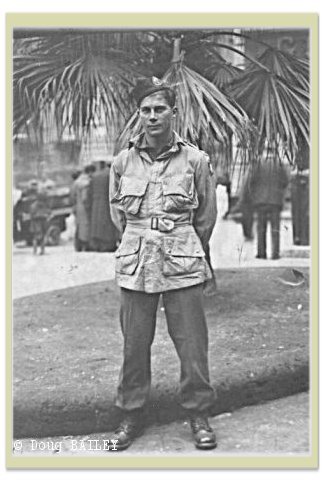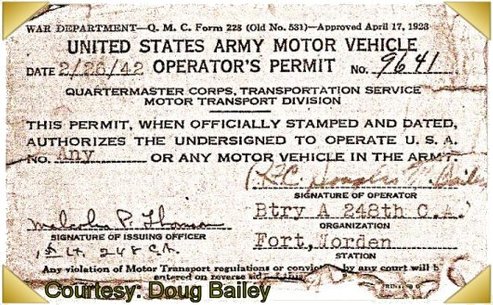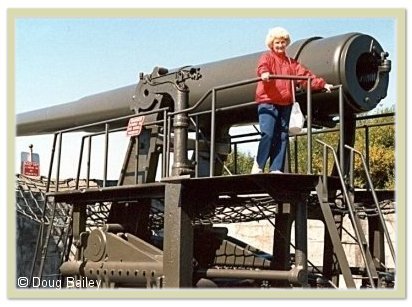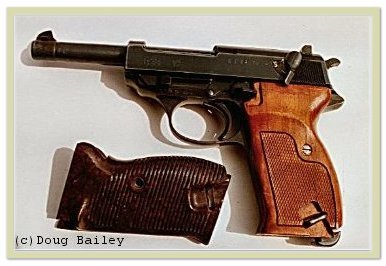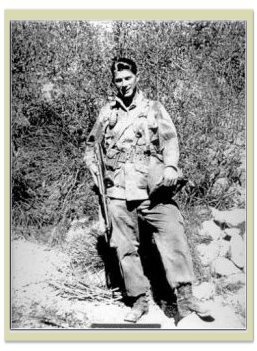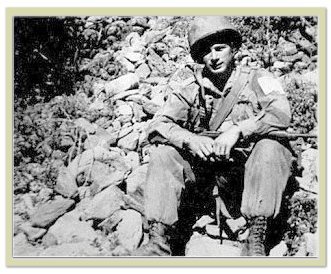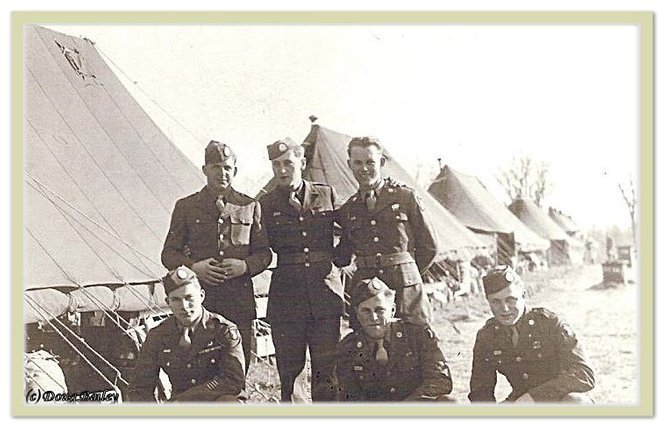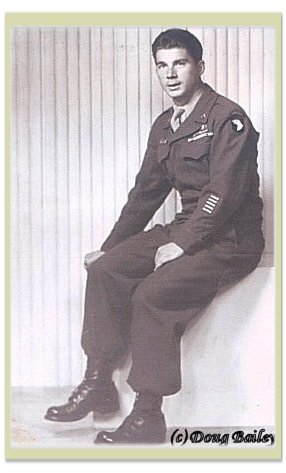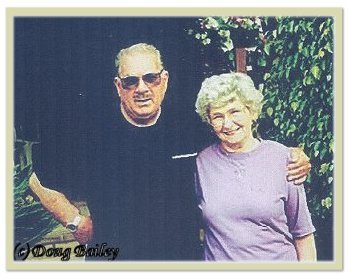In December 1939 I read in the local paper that Port Angeles was going to have a National Guard unit.
It was to be A-Battery of the 248th Coast Artillery Regiment. I and a few of my Classmates who were in the Junior Class in High School all lied about our ages and joined up.
We went two weeks into our Senior Year when the late President Roosevelt called up most of the National Guard into Federal service.
We were sent to Fort Worden, WA.
A-Battery was assigned to a 10" Disappearing Gun Battery.
I was in the Motor Pool for awhile at my Coast Artillery Fort before I went to the Paratroops. I drove the big 6 X 6's and 4x4 Weapons Carriers and Jeeps
Doug Bailey in Naples, December 1943
I was with Ben Ziegler from my 4th Gun Section
For 3 days at the 5th Army Rest Center.
Trooper Private Douglas 'Doug' BAILEY
March 4, 1922 (Port Angeles, WA)
I still have my copy of my Army Driver's permit.
When I first went into the Service, to take the exam for Pilot Training you had to have two years of College. As the War went on you had to have Graduated from High School and then it got down to have a certain Score on a IQ test.
A friend in my outfit and myself put in for Pilot Training and they sent us to Seattle to take the Test. We took the mental Exam in the morning and both passed but I did not pass the Physical because I was Color Blind. My friend passed and later was killed in a B-17 over Germany.
I then put in for the Parachute School and did not pass the color Blind test. (I did not know about the color Blind test to be a Paratrooper) or I would not have even taken the test. So I went back to regular duty and then received a letter saying I could be a Glider Pilot. So I put in for that but a week or so later I receive another letter saying the Qualifications had been changed and were the same as the Air Force.
So I almost gave up and one day I was told to report over to the Post Hospital and the Doctor who gave me the test said you are in good Physical condition and said do I really want to go to the Parachute School. I said I did and he pointed to a large Desk Blotter and said what color is this I said Green. Ok, he said and about 4 days later I was on my way to Fort Benning.
Eventually seven of us from A-Battery 248th Coast Artillery became Paratroopers. Four of us went to Europe and three went to the Pacific War. I left Fort Worden January 1st 1943 for Fort Benning and the Parachute School. Made my qualifying jumps and sent to the 82nd A/B Div. at Fort Bragg, NC. Was only at Fort Bragg a short time and then it was off to North Africa, and our long Trek would begin.
This is the type of Coast Artillery Gun
I served on before I went to the Parachute School at Fort Benning, Georgia.
It was called a 10" disappearing type Gun
That's my Wife Dorothy on the Gunners platform,
the Breech Block is missing and also the Gunners Sight.
The gun is now at ( Fort Casey ) a Washington State Park.
This is a German 9mm Walther P-38 that I brought home from the war.
I replaced the Bakelite Handles with Wooden Handles or what we call Grips.
The German I got it from no longer needed it...
Another German souvenir
I brought home...
Interview with Mr. BAILEY
Q. Where and when were you born? Do you have any recollections of the time you went to school or about your childhood?
I was born March 4th 1922 in Port Angeles, Washington situated on the straits of Juan De Fuca 18 miles
across from Victoria, British Columbia (Canada)
I had a wonderful childhood growing up in a small town with lots of Playmates and lots of things to do
I joined the Washington National Guard when I was a Junior in High School and went two weeks of my Senior year when my Guard Unit, Battery A 248th Coast Artillery was called into Federal service.
Q. What did you think when you first heard about the Japanese attack on Pearl Harbor?
Did you realize immediately the USA was now involved in a global war ?
I had just come off Guard and crawled into my Bunk when someone came into the Barracks and told us about Pearl harbor.
We immediately drew rifle ammunition and went up to the 10" Disappearing Gun Battery we were assigned to and waited for the Japanese Fleet to come steaming up the Straits. (It never showed up).
We were not surprised as we were called into active service along with many, many National Guard units on September 16th 1940 almost a year before the attack on Pearl Harbor. My parents had no objection to my joining the National Guard although I told the Recruiters I was 18 yrs old but I was really only 17 yrs old.
Q. What are the different places where you had your training and what kind of training did you have?
Do you have any memories of the time you were in training, good and/or bad? How was the food for instance?
Were you allowed to go home sometimes, or did you have some time off once in a while?
Since I joined the local National Guard Unit we did not have the regular Basic training we would have got if we had joined the Regular Army. We were lucky to have quite a few guys that had spent a enlistment in the Army, Marines, Navy. They made them the Corporals and Sergeants right away.
The Captain in civilian life was a County Engineer. We did go to one summer camp and Fired the 10" Disappearing Guns.
After we were called up and stationed at the Fort which was only fifty miles from our home town we could get home in a hour so we got home quite often.
I had no complaint about the Food as it was OK. The Mess Sgt. was a old timer who had spent time in the Regular Army.
Did you know that in the peace time Army you could buy your self out for $129,00 dollars. The pay was only 21 dollars a month so it was hard for Soldiers to save $129.00 after having your pay deducted for Dry Cleaning, Laundry, Theatre Tickets, Post Exchange, and gambling Debts.
Q. Did you have different jobs in the Battalion, in the 456th or/and in the 463rd ?
When I first joined the 456th I was assigned to the B Battery 4th Gun Section and stayed there my whole Airborne Career.
I aso when called upon was a Bugler since I knew all the Bugle Calls.
Q. Do you have any recollections about the Operation Anvil-Dragoon in Southern France in August 1944 and or do you have any
recollections about the time you were in the Alps trying to stop the retreating Germans fleeing from Italy ?
Yes ! This is my story I wrote for my Kids years ago about Dragoon:
"OPERATION DRAGOON " with the "FIRST AIRBORNE TASK FORCE"
THE INVASION OF SOUTHERN FRANCE
By Douglas M. Bailey
Who served with the
456th Parachute Field Artillery Battalion, 82nd Airborne Division
463rd Parachute Field Artillery Battalion, 1st Airborne Task Force
463rd Parachute Field Artillery Battalion, 101st Airborne Division
The First Airborne Task Force was made up of the Independent Parachute and Glider Units in Italy in 1944
551 Parachute Battalion 463 Parachute Battalion ***
517 Parachute Combat Team 509 Parachute Battalion
550 Glider Battalion British 2nd A/B Brigade
Before we were assigned to the First Airborne Task Force, my Battalion the 463rd Parachute Field Artillery Battalion was designated the 456th Parachute Field Artillery Battalion and we belonged to the the 505 Parachute Infantry Regimental Combat Team in the 82nd Airborne Div.
After we had jumped in the invasion on the Island of Sicily shortly after midnight with the 82nd A/B Division , we were sent to Italy and we were attached to the American/Canadian First Special Service Force. This was a Special Unit that had both Americans and Canadians in it, they had Mountain and Parachute training. We served with them on the Casino Front, the Anzio Beachhead, and the drive to Rome. When my Parachute Battalion was pulled out of the lines after Rome was captured, we first went to Lake Albano, which is South of Rome and where the Pope has his summer residence.
After a short time we moved out to the coast to LIDO DE ROMA which was a summer resort for the wealthy Italians. Here we received replacements to build the 463rd Parachute Battalion up to full strength for the next Combat Jump. They sent some Officers back to the Replacement Depots in Africa to hand pick the qualified Troopers.
Just before we left Lido De Roma some Engineers came out with a compressor and spray guns to camouflage us. We fell out with our jump suits on, and all our webbing and Musset bag. One guy sprayed us with black paint and the other guy sprayed us with green paint. We also had tubes of grease paint to paint our faces, so by the time it came to load the planes, we would be a mean looking bunch. We Left the Rome area and went north about 100 miles to the Grosseto Airport where we would take off for France. We left around midnight and flew west over the Ligurian Sea, then North about on the same route that Napoleon took when he returned to France from exile.
The 463rd and the 509 made up a Combat Team, and we took off about 40 minutes before the rest of the Airborne. These two little Bastard Battalions spearheaded the attack. Jumping around 4:30 in the morning, just before daylight, we were supposed to jump at a place called Le Muy about 15 miles inland, but quite a few plane loads of the 463 and 509 got the green light over St. Tropez, which is on the coast. When we went to the planes to Chute up, there were two extra main chutes and two reserves left over at our Plane, so we just threw them in the plane. About half way to France one of the guys got his back pack snagged and the chute came out behind him. So we grabbed one of the extra chutes and somehow, in that dimly lit plane, got the old one off and the new one on over all the equipment.
When they made the big plan, they did not figure that when all those planes arrived over the coast, that the coast and miles inland would be covered by low clouds. When I went out the door and my chute popped open, I immediately entered what I thought was a ground mist or fog and got ready to hit the dirt. I came out of that cloud and went into another one, and thought this must be a ground fog. I came out of that one and then I could see in the moonlight that we were coming down on the coast. I could see the coast line real clear in the moonlight and knew that they had dropped us in the wrong area I could see that I was over land, but not by much, so I grabbed my front risers and tried to slip further away from the coast and the Ack Ack fire, which I had become quite allergic to after the Sicily Invasion Jump. We had jumped from quite a high altitude, in fact the highest I ever jumped, so it was quite a long ride down . ( One whole planeload of 18 Troopers from the 509 were lost when they came down through the clouds to land in the water and they all drowned.)
I came down on a dirt road with trees on both sides, and could hear other Troopers coming crashing down through the trees and high brush. I scurried over to a ditch and had a heck of time getting out of my Chute. The Belly band that goes between your body and through the reserve chute had twisted up my back, and I could not reach the Quick release tab. I had to get my Jump Knife out to cut myself loose. The first guy I met was out of my gun section. He was an Apache Indian from the San Carlos Indian reservation in Arizona. He had joined us as a replacement on Anzio. We joined up with a few others, captured one garrison and took many prisoners, and also captured a large pill box on the beach, and took them prisoners too. Most of them were not Germans but from other Balkan countries that the Germans had captured and impressed into the German Army . They had German uniforms and had German equipment. The big Pill Box we captured had a German Sgt. and Corporal, but the the other 12 or 14 soldiers were these other troops. We also got into a street fight in St. Tropez with some German Marines, but they soon showed the white flag.
While all this was going on, other 463rd guys were capturing a German Coastal Battery. Jay Karp, who was one of the guys that made that charge up the hill told me, " We came upon a Lt. Rosen, who had been shot in the rump. He hollered at us. Don't mind me go get those Bastards. " ---" So we did"
Col. Cooper, the Battalion Commander, broke his leg on this jump and was sent to a Hospital in Africa. He rejoined us months later when we were up in the French Maritime Alps. Later that evening we turned our prisoners over to the 3rd Infantry Division that had landed, and we moved by Amphibious Ducks to La Muy, which was our original Drop Zone. After we got together with the 463rd and 509 guys that did drop at Le Muy, we continued along the coast until we got to the outskirts of nice. at one point we came to a river and the Germans had blown the bridge. There was a blown up Jeep that had hit a mine with pieces of the jeep in the branches of a tree and what looked like clothing or body parts.?? The Engineers had marked a path with white tape down the bank of the river which was fairly shallow and the trucks started down to cross. Most of them made it. But the truck behind us turned too soon and did not follow exactly and hit a mine in the middle of the river and blew up, I could see two guys flying threw the air over the side of the truck and come splashing down in the River. One suffered a broken leg, and I heard later that the other guy, I think his name was" Felton" was paralyzed from the waste down.?? They were the only two really hurt. The rest were pretty shook up, and the truck was totaled. Later two more 463 troopers were wounded when there Machine gun position was hit by mortar fire.
One was named " Tolster " who was a ex Marine and had served in China. On the Transport that took us to N. Africa, the Matson Liner S.S. Monterey, he ran into the Captain of the S.S. Monterey's steward, and that Steward had owned a Bar in Shanghai that "Tolster" use to patronize. They looked at each other and recognized each other, and had a Mini-reunion right there down on "D" Deck. (Small World). We boarded the S.S. Monterey in New York for the 12 day trip to North Africa where we disembarked at Casablanca. On the ship they only served two meals a day, and we only had a bunk to sleep in every-other night. The nights we did not have a bunk to sleep in, we just found a place on deck to sleep. The S.S. Monterey had been a Cruise ship for the Matson Line that went from San Francisco to Hawaii in peace time. It had been converted to a Troop ship. There were about Five Thousand Troops aboard, mostly out of my Division. The 82nd Airborne Division.
A few days after the capture of NICE, we were on our way to the mountains. The 463rd along with a Glider Battalion was sent up into the French Maritime Alps to fight as Mountain troops. It Took about two days for the trucks get up in the Mountains to our Destination in the Alps. We had our Rear Echelon in a Pass through the mountains in the town of BARSLONET, and our front line positions near the village of JOUSIE. We were told that this was the same pass that Hannibal took his Elephants through on the way to Italy.??
B Btry had a good position on the side of a mountain and did not receive too much counter battery fire. The other batteries further down from us took a lot of fire. I believe one Battery had to move a couple times. They sent one Battery way up higher on a mountain, and while there were covered by deep snow and became ineffective. They took 3 or 4 men from each gun section. and sent us up the mountain to help dig out the road so the snowbound Battery could get out. I did not mind going up there, although the snow was about 8 ft deep in places. We really worked up a sweat shoveling that snow. I think we were in the mountains for about 3-1/2 months. We lived on C & K Rations and once in a while we had 10 in 1 Rations. I think they were packed in England. Because in each box was a great big can of Beef and Kidney Stew which was the worst food I ever tasted. Even now I shudder when I think of it. We were finely relieved by French Moroccan troops from North Africa that had Mules to get around with. The 463rd moved back down along the French Riviera.
Doug Bailey in France, 1944
Q. If I am not wrong the 463rd PFA arrived in Mourmelon, France, just a few days before the start of the Battle of the Bulge.
Col. Cooper asked to join the 101st Airborne on their Rendezvous with Destiny and then the Division headed first
to Werbomont, just a bit later the plans changed and the 101st went to Bastogne. When did you find out that you were
going into combat again? How was the trip to Bastogne?
Woke up one morning at Mourmelon Le Grand and got the word that we were moving out and at that time I did not know where we were going.
This is my story I wrote for my Kids years ago about Bastogne, and also on demand of Col. Cooper:
About 10 years or so ago, Col. Cooper sent out letters to those of us that were at Bastogne to write and send him the memory's of our experience at Bastogne during that Battle. As my experience only lasted from the time we arrived in the area around December 19th until the 24th when I was wounded, and until around the 27th when the Ambulances got there and took the wounded out.
To: John T. Cooper
Dear John;
In your last letter to the troops, you asked us to tell what we did during the German tank attack on Christmas day.
My story must start on the 24th of December. I had Just moved back to the 4th gun section after spending all night standing in a foxhole on a snow covered slope out in front of B Battery's Gun position. When we went out to dig our defense line, Captain Cole passed out the last of the rifle ammunition and Grenades, We knew we were surrounded by the German Panzer, Parachute and Infantry divisions. We also knew about the surrender note and demand, so we knew we had to hold the position . During a fire mission later that morning a shell exploded right in front of the gun position, and for some reason there were only three of us on the gun at that time. Don Zafke, Cecil Farmer, and myself, and all three of us were wounded.
Tom (Doc) Pace our Medic came running across the snow and gave us some help, and patched us up as best he could , and then a Jeep came over to us , and they threw us in the Jeep and took us to the Church in Hemroulle that they were using as a aid station. The wounded were put along the wall. The Americans on one side and the wounded Germans on the other. This was only about 150 yards from where we were wounded. They used the equipment bundles and parachutes that came from the re-supply drop on the 23rd December to cover us.
The re-supply drop came just in the nick of time, as our squad had about 5 rounds of HE (High Explosive), about 6 rounds of AP (Armored piercing), and about 3 rounds of WP (White Phosphorus).
The concussion from the exploding shell made my legs numb, and I felt no pain. After lying on the floor for about a half hour, I started to get feeling again in my legs and I started to hurt. They had bandaged up my left leg where the shrapnel went in.
My right foot started to really hurt. I worked my hand down to my boot, and I could feel that it was all clammy. I called one of the medics over and they found that I had been hit in the right foot also.
Christmas day during the battle, All we could do was lie there and wonder what was going on. Shell fire broke the windows above us and the glass fell down an us, and one or two shells came through the roof exploding in the Church and re-wounding some already wounded Germans.
At one time during he battle, we could hear a tank running outside the church. When someone opened the door, I raised up, took a look and saw a German tank. I thought we had bought the farm. It turned out that it was one of the ones we had knocked out, and Booger Childress got it running and drove it into our lines. Heard later that they used it for a road block.
I don't know how long we laid in the church in Hemroulle before they roved us to the aid station in Bastogne. There wasn't anything they could do for us there. because the Surgical teams that were following the Division to Bastogne were cut off and captured. Also the room that had the whole blood plasma was hit by a shell that wiped it all out.
A building next door to the one we were in was hit by bomb's and caught fire killing most of the wounded and a Belgium nurse that was helping out. The wounded coming in with critical wounds, like stomach wounds, were just put over by the wall. There was nothing that could be done for them.
There was still quite a bit of shellfire hitting the town, but after surviving the Sicily Jump, Casino front, Anzio, and the Jump into Southern France, and the French Alps, I thought I was Invincible, Indestructible, and Immortal. At one time after a bout of shelling, I noticed the Chaplain going down the long line of wounded lying on the straw covered floor giving everyone the last rites.
When he came to me, he asked if I wanted them administered to me? I told him I wasn't Catholic. (I thought only Catholics did this.) Anyway, he gave me the last rites and moved on to the next man.
At that time things were looking pretty grim. The only thing I remember having to eat all this time was some English Taffy that was put in some of the re-supply bundles that were packed in England. I also heard about this time that James Ragsdale, who had been in my gun squad, had been wounded and then killed when the ambulances taking the wounded to the rear were ambushed and shot up.
When the 4th Armored Division broke open a road to us, the ambulances were loaded, and we were off over ice and snow covered roads through the Ardennes to a Evacuation Hospital in Thionville, France. Here they operated on me and took the shrapnel out of legs. I was here a few days and then we were taken out to an airfield where they more to fly us to Paris. This was a new tent holding area run by a Chemical Warfare Battalion. They were over there with all their nasty gasses in case the Germans used Gas on us. Since the Germans were not using Poison Gas, they had this outfit running this tent city taking care of helping, and transporting the wounded coming out of the Bulge fight.
I read somewhere that this was the coldest winter In Europe in 40 years. I believe it. We laid in those freezing tents on stretchers about 4 days. Didn't know which would come first. Would we freeze to death or starve to death first? This area was near an Airfield and since the weather was too bad to fly us out, they finally loaded us in ambulances again and took up to a railway where we were loaded on a Hospital Train.
We finally arrived in Paris where we were unloaded and carried to waiting ambulances by German Prisoners of war. I had a tag around my neck that had CZ on it. This meant that I was to go to a Hospital in the Paris area. CZ stood for Communications Zone . The Hospitals were full, so they changed the tag to UK which stood for United Kingdom, so now I was to be flown to England. They loaded us up on a C-47 that was rigged up with stretchers. I was put in a top stretcher up where the roof curved over.
I felt like I was in a coffin with the lid half closed. They flew us to Southern England, and I ended up in the 106th General Hospital near Bournemouth. They operated on me again in England, and then it was just a matter of letting time and good care do the healing. We had pretty Nurses, good chow, clean sheets, music in the ward, and even a movie once in a while. Another time I was taken by wheel chair to a U S 0 show at the Hospital. While I was putting up with all this, the Battalion was still in Belgium enjoying winter sports! Ha!!!!.
Finally I was released from the Hospital and sent to a replacement center near Birmingham, then to Southampton, over to Le Havre, and then to another replacement center up near the Belgium Border. At this time there was no guarantee that I, or anyone else would be sent back to their original outfit, they would just ship you to the Airborne unit that needed replacement the most. Needless to say this did not go over too well and the guys were just taking off from the center as soon as they found out where their original outfit was. I was about to do this, except I had heard the Battalion had left Belgium and was somewhere in Luxemburg. A few days later I heard that they had moved back to France, and about that time they changed the policy at the center , and so you knew you would be sent back to your own outfit.
I rejoined the Battalion at Mourmelon La Grande about a week before we loaded up and moved into Germany up on the Rhine River by Dusseldorf. We then headed south and were down by Munich when the war ended, and our long trek was over.
EPILOG
Colonel John T. Cooper:
Became Battalion commander after Colonel Hugh Neal was badly wounded shortly after we broke out of the Anzio Beachhead. After the war Colonel Cooper went back to practicing law.
Colonel Hugh Neal:
Became Battalion commander an the Island of Sicily, after we lost Colonel Harrison Hardin. After the war went back to building Bridges as a Engineer. Was from Baton Rouge, LA.
Captain Ardell Cole:
Became Battery commander of B Battery after Captain Harris was killed on the Anzio Beachhead. After the war became a Judge, an now retired, he lives in Paris, Tennessee.
Captain John S. Moore. (Battalion Medical Officer)
The Doctor that did such wonderful work on the wounded through all the battles. After the war went back to private practice in Albuquerque New Mexico.
Tom (DOC) Pace:
Was not really a doctor, but one of the two medics assigned to
B Battery , everyone called him Doc. The other original medic was killed in the first few minutes of the Sicily Invasion. After the war Pace moved from Nebraska to Oregon where he worked in heavy construction. Now retired he lives in The Dalles, Oregon.
Cecil Farmer:
Badly wounded at Bastogne spent about 9 months in Hospitals in England and in the United States. After Discharged, worked for the Government in El Paso, Texas.
Donald Zafke:
also wounded at Bastogne, Went to Hospital in England. After discharge from Hospital rejoined the Battalion in France. After the War worked as a Architect for the State of Minnesota. He lived in White Bear Lake, Mn.
Booger Childress:
Not his real name, but everyone called him Booger. Was the one who put his undershirt over the barrel of the gun of the knocked out tank and got it running and drove into our lines. He was from Cowpens, South Carolina.
Doug Bailey
Was also wounded at Bastogne, went to Hospital in England. After discharged from Hospital, rejoined the Battalion in France. How retired and living in Port Angeles, Washington.
I did not rejoin the 4th Gun section until I got out of the Hospital in England
and the 101st + 463rd was back in France at Mourmelon Le Grand.
Back row, left to right: Don Zafke, Bowensox, Wilson
Front row, left to right: Doug Bailey, remplacement ?, Don Gallipau
Q. When the war ended in Europe early May 1945, the USA was still at war with Japan.
Was there a possibility that the 463rd would have received a new assignment in the Pacific ?
I don't know much about that either as I had lots of Points and was in the first bunch to leave for home from Bad Reichenhall in southern Germany.
Q. Looking back : what or which scene grabbed you the most ?
When we got pulled out at Rome and were stationed at Lido De Roma a couple little Brothers use to hang out around the building for food and one day one of them picked up a German Grenade someplace and was pounding it on a wall and it went off and killed him, we rushed him to the Medics but it was too late they could not save him.
I do not think I will ever forget that incident.
Q. What did you do after the war ended ?
My first job was a Fireman on a Logging Train. I had many jobs after that In a Paper Mill, Montgomery Ward Department Store, a Crown Zellerbach Paper Company, Manager of a Grocery store, was a partner and owner of a Plywood Mill, and sold the Mill to ITT Rayonier a pulp Mill, I retired and got tired sitting around took the exam for a Real Estate salesman and after 12 years retired completely.
Picture taken 2 days after comming home.
Doug and his lovely wife Dorothy
Thank you Mr. Bailey !






